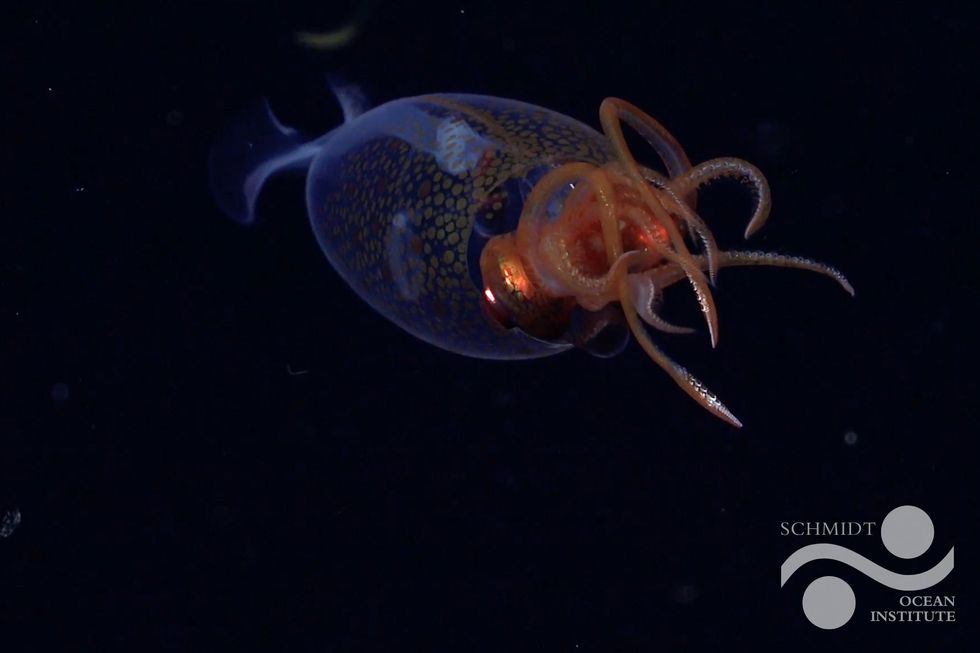Live Colossal Squid Sighting On Film For The First Time In 100 Years
The vast ocean still holds secrets that scientists are only beginning to uncover. Despite covering more than 70 percent of our planet, large parts remain unexplored, especially in the deep sea where sunlight never reaches.
Every expedition into those dark depths brings the chance to see something no human has ever witnessed before, and sometimes, those moments come in the form of creatures we thought we knew only from washed-up specimens or scattered bits found in whale stomachs.
Earlier this spring, researchers experienced just such a moment: live footage of a juvenile colossal squid, recorded for the first time in its natural habitat. The rare sighting occurred on March 9 when SuBastian, Schmidt Ocean Institute’s remotely operated vehicle (ROV), spotted the squid about 600 meters off the South Sandwich Islands.
According to the team, the little squid measured roughly 30 centimeters long—tiny compared to the seven-meter adults we’ve only ever found deceased. Discovered more than a century ago, Mesonychoteuthis hamiltoni has long been recognized as the world’s largest invertebrate by weight, tipping the scales at up to 500 kilograms.
Until now, our understanding of this species has come from dead specimens stranded on beaches or found inside the stomachs of sperm whales. Seeing a live juvenile individual gliding through the inky water is a milestone in squid biology and deep-sea exploration.
A juvenile colossal squid (Mesonychoteuthis hamiltoni) gliding through its natural Atlantic Ocean habitat.
This finding was part of a 35-day expedition led by the Schmidt Ocean Institute in collaboration with the Nippon Foundation–Nekton Ocean Census, along with research teams from the UK and Germany. Their goal was to survey poorly studied regions of the Southern Ocean and support that work with high-definition video and environmental data.
So far, SuBastian has captured the first confirmed footage of at least four deep-sea squid species, and the team knows there are more mysteries waiting to be identified.

Experts on board quickly confirmed the squid’s identity by looking for two key features: a clear, almost see-through body and a series of hooks along its arms. Those hooks help distinguish this species from others, like the glacial glass squid (Galiteuthis glacialis). In fact, a glacial glass squid was filmed live for the first time just weeks earlier, during a Schmidt Ocean Institute mission in January in the Bellingshausen Sea off Antarctica.
“The first sighting of two different squids on back-to-back expeditions is remarkable,” said Dr. Jyotika Virmani, Schmidt Ocean Institute’s executive director. “It shows how little we’ve seen of life in the Southern Ocean.”
Understanding Deep-Sea Life
Dr. David Gruber, a marine biologist known for his work on deep-sea creatures, emphasizes the importance of technological advances in exploration.
He states, "The use of remotely operated vehicles (ROVs) and submersibles has revolutionized our ability to study previously unreachable depths, allowing us to observe the behaviors of creatures like the colossal squid in real-time."
This kind of observation not only enhances our understanding of these species but also informs conservation efforts, as many deep-sea organisms are vulnerable to climate change.
These juvenile squid can grow up to seven meters in length when fully mature.
Beyond the colossal squid, SuBastian has already recorded footage of several other species that dwell in these deep, cold waters. One remains unidentified, still awaiting a closer look by taxonomists.
As these videos roll in, they’re helping scientists piece together an ecosystem where few have ventured and even fewer have studied.
“These moments remind us just how much of the ocean remains unexplored,” Dr. Virmani added. “Every time that camera lights up, we learn something new—and most of it is completely unexpected.”

Dr. Kat Bolstad, a cephalopod specialist who helped verify the giant squid footage, called the discovery thrilling and humbling. “It’s exciting to see the first in situ footage of a juvenile colossal squid, and humbling to think that they have no idea humans exist,” she said.
She explained that this sense of wonder comes from realizing that these animals have evolved over millions of years without ever needing to know about us, and yet here we are, getting our first real look at how they live.
The team’s work isn’t just about flashy video. Each dive collects water chemistry data, temperature readings, and samples of microscopic life, all of which contribute to broader efforts to map and protect the ocean’s biodiversity.
By combining high-resolution imagery with environmental sensors, researchers can start to understand the conditions that allow species like the colossal squid to thrive and how things might change as the climate warms.
Filming a live colossal squid may grab headlines, but the data behind the images will shape our understanding of the deep sea for years to come. The expedition continues through the end of March, and scientists already have plans for follow-up trips to track other elusive creatures.
In the meantime, this glimpse of a juvenile giant—alive, agile, and utterly unaware of its fame—reminds us that exploring our planet can be just as thrilling as venturing to distant stars.
Marine conservationists highlight that the sighting of a living colossal squid raises questions about the health of ocean ecosystems. Dr. Sylvia Earle, a renowned marine biologist, asserts, "The ocean's health is a reflection of our planet's overall well-being. Protecting these habitats is crucial for all marine life."
To better protect these ecosystems, Dr. Earle recommends increasing marine protected areas and implementing sustainable fishing practices.
She believes that engaging local communities in conservation efforts creates a sense of ownership, leading to more effective stewardship of marine resources.
Psychological Insights & Implications
The recent sighting of the colossal squid reinforces the need for continued exploration and conservation of our oceans. Experts like Dr. Gruber and Dr. Earle remind us that our understanding of marine life is still evolving, and with it comes the responsibility to protect these fragile ecosystems.
As we learn more about creatures like the colossal squid, we must also commit to sustainable practices that ensure their survival. Preservation efforts can only succeed if we recognize the interconnectedness of all life forms within the ocean.



